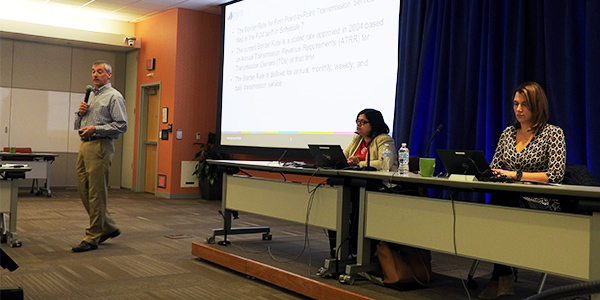VALLEY FORGE, Pa. — The PJM Market Implementation Committee endorsed two fuel-cost policy (FCP) packages — including one authored mid-meeting — that would consider the market impacts of breaking the rules and adjust penalties accordingly.
The first package, compiled by a group of stakeholders, won 87% support and will advance to the Markets and Reliability Committee as the main motion next month. The plan reduces penalties when a market seller self-identifies violations of its FCP and provides safe harbor for situations of noncompliance that weren’t contemplated by the policy. The plan would also expand the use of temporary FCPs. (See PJM MIC Briefs: Nov. 13, 2019.)
PJM’s Glen Boyle, however, questioned how the plan would apply penalties, noting that existing language could allow for duplicate benefits. The plan would fully penalize units that clear the day-ahead market or run in real time on a cost-based offer and are either paid day-ahead/balancing operating reserves or have cost-based offers above $1,000/MWh. If a market seller self-identifies noncompliance to PJM and the Independent Market Monitor, the penalty is reduced 75%.
“There could be a scenario under this proposal where a cost-based unit running on its cost-based schedule is the marginal unit setting price and still getting a discount on the penalty,” he said. “I think that position is a little tough to justify.”
Adrien Ford of Old Dominion Electric Cooperative acknowledged that the scenario could occur but said it wasn’t a big enough risk for stakeholders to consider modifying their plan.
“Knowing whether or not there was an impact is tough, so we are coming up with something to indicate that there might have been an impact,” she said. “I think what you’re pointing out is a thin risk that there could be an impact and it wouldn’t be assigned. It is likely that a marginal unit would be paid DA/balancing operating reserves and caught by the impact test. There’s no perfect test, but we think this is a pretty good one.”
The PJM Industrial Customer Coalition and Calpine offered revisions to the first package that they said would address Boyle’s concerns. When it wasn’t accepted as a friendly amendment, the two stakeholders proposed the alternate language as a second package on which the MIC would vote. The revisions clarify that the full penalty would be imposed if a unit is marginal in the day-ahead or real time on its cost-based offer. A unit committed on its price-based schedule that later fails the three-pivotal-supplier test during its minimum run time or hours of its day-ahead commitment would also not incur the full impact factor unless the other conditions for market impact were met. About 81% of the committee endorsed these small language tweaks too.
The Monitor withdrew its package in support of PJM’s own set of revisions, which only won 29% support from the MIC. The RTO also rescinded an alternative package that offered its own version of an impact factor.
Parameter-limited Schedules
PJM and the Monitor presented their divergent views to the MIC on the implementation of parameter-limited schedules (PLS) and whether governing document revisions are needed.
According to PJM, Tariff and Operating Agreement language errors introduced with the implementation of Capacity Performance means that the RTO’s practice regarding PLS contradicts its own rules and conflicts with other governing documents. The Monitor said, however, that PJM should simply follow the language set out in the Tariff instead of revising the document to fit its current practice.
“What we want to do is make sure the Tariff reflects what’s in that manual,” PJM’s Adam Keech said. “The Tariff conflicts with what’s in the manual, and the manual is the correct implementation.”
According to the Monitor, however, the compliance issue rests solely with PJM’s misinterpretation of the Tariff. The RTO’s current implementation of PLS does not mitigate the exercise of market power, as it was intended to do, the Monitor said.
Both the Monitor and PJM discussed their viewpoints with the MIC at the request of the MRC on Dec. 5. The conversation will continue Dec. 19 when the MRC considers Tariff changes authored by PJM to align PLS with the manuals.
Border Rate Manual Revisions
The MIC endorsed revisions to Manual 27: Open Access Transmission Tariff Accounting that would reflect FERC’s recent order on border rate calculations (ER19-2105).
In June, PJM transmission owners submitted a filing that updates the yearly border charge to prevent network integrated transmission service (NITS) customers — network load located outside the RTO’s boundaries but served from within — from subsidizing border and non-zone service rate customers who use transmission service through and out of PJM. (See Settlement Hearing Set for PJM Border Dispute.)
FERC accepted the TOs’ filing subject to refund, with an implementation date of Jan. 1, 2020, but also set a paper hearing and settlement procedures for involved parties to work out their differences over the proposed methodology behind the rates.
PJM’s Market Settlements Development Department said the manual revisions will move forward but acknowledged that refunds will be issued if changes to the methodology are approved in a settlement.
– Christen Smith




